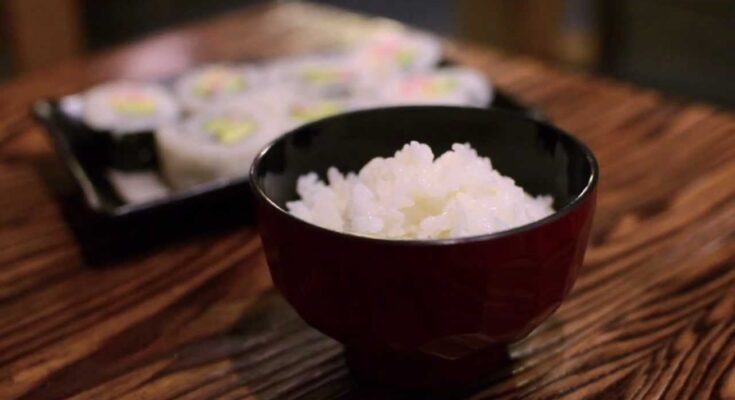Sushi Rice Recipe: Sushi rice is at the heart of every good sushi dish. Known as shari in Japanese, this flavorful and slightly sticky rice is the canvas that holds everything together in sushi rolls, nigiri, and even poke bowls.
Making sushi rice isn’t just about cooking rice; it’s an art form that requires balance, technique, and a few precise steps.
Here, we’ll go over everything you need to know to make sushi rice at home, from selecting the right ingredients to creating the perfect flavor and texture.
Ingredients Needed for Sushi Rice
To create authentic sushi rice, you’ll need a few specific ingredients, which you can find in most grocery stores or Asian markets. Here’s what you’ll need:
- Sushi Rice (short-grain rice): Short-grain rice is essential due to its sticky texture, perfect for forming sushi shapes.
- Rice Vinegar: Adds a gentle acidity and balances the rice’s natural sweetness.
- Sugar: A small amount is mixed with the rice vinegar to bring out the subtle flavors.
- Salt: Balances the flavors and enhances the rice’s natural taste.
- Water: Use filtered water if possible to avoid impurities that might affect the flavor.
These ingredients work together to give sushi rice its characteristic taste, which complements the flavors of fresh fish, vegetables, and seaweed in sushi dishes.
Essential Equipment for Perfect Sushi Rice
Having the right equipment can make a big difference when preparing sushi rice. Here’s what you’ll need:
- Rice Cooker: While sushi rice can be made on the stovetop, a rice cooker makes it easier to get the perfect texture every time.
- Large Bowl: Used for rinsing and mixing the rice.
- Wooden Spatula (Shamoji): Essential for mixing the vinegar into the rice without crushing the grains.
- Large Flat Dish (Hangiri): A traditional Japanese wooden container for cooling and mixing sushi rice, though any large, flat container can work.
Each tool serves a specific purpose, helping to create the ideal texture and flavor in your sushi rice.
Choosing the Right Type of Rice
For authentic sushi rice, it’s crucial to choose the correct type of rice. Look for Japanese short-grain rice, often labeled specifically as “sushi rice.” This rice variety is stickier than long-grain rice types, which allows it to hold together well in sushi. If you’re shopping at an Asian grocery store, brands like Nishiki, Kokuho Rose, or Tamaki Gold are popular options for sushi rice.
Preparing Sushi Rice: A Step-by-Step Guide
Let’s dive into the process of making sushi rice. Each step is important to achieve the perfect texture, flavor, and consistency.
Step 1: Washing the Rice
Washing is essential for removing excess starch from the rice, which prevents the rice from becoming overly sticky. Follow these steps:
- Place the rice in a large bowl and fill it with cold water.
- Gently swirl the rice with your hand, then pour off the cloudy water.
- Repeat this process 3–4 times until the water is almost clear.
Washing the rice properly will ensure that each grain remains separate but sticky enough for easy shaping in sushi rolls.
Step 2: Soaking the Rice
Soaking is a crucial step that allows the rice to absorb water and cook evenly. After washing, let the rice sit in water for at least 30 minutes. This soaking time will help the rice become tender without overcooking or losing its shape.
Step 3: Cooking the Rice
For cooking sushi rice, you have two main options:
Using a Rice Cooker
- Place the washed and soaked rice in the rice cooker, adding water according to the rice cooker’s instructions.
- Set the rice cooker to the appropriate setting and let it cook.
Stovetop Method
- In a pot, combine the washed rice with water at a 1:1 ratio.
- Bring the water to a boil, then reduce the heat to low, cover the pot, and let it simmer for 15–20 minutes.
- Once cooked, let the rice rest for 10 minutes before fluffing.
The rice should be tender but not mushy, with each grain holding its shape. Once finished, transfer the rice to a large, flat container for the next step.
Step 4: Preparing the Sushi Vinegar
The flavor of sushi rice comes from the sushi vinegar mixture, known as su. Here’s how to make it:
- In a small saucepan, combine ¼ cup rice vinegar, 2 tablespoons sugar, and 1 teaspoon salt.
- Warm the mixture over low heat until the sugar and salt dissolve completely.
- Remove from heat and let it cool slightly.
This vinegar mix will be gently incorporated into the rice to provide the tangy, slightly sweet flavor sushi rice is known for.
Step 5: Mixing Vinegar into Cooked Rice
Once the rice is cooked and the vinegar is ready, it’s time to combine them:
- Transfer the hot rice to a large flat dish (or hangiri if you have one).
- Drizzle the vinegar mixture over the rice.
- Use a wooden spatula to fold the vinegar into the rice, using a gentle slicing motion to avoid crushing the grains.
- While mixing, fan the rice to help it cool quickly, which will add shine and prevent over-stickiness.
The rice should be slightly sticky but not mushy, with a glossy finish. Allow the rice to cool to room temperature before using it in sushi.
Tips for Perfect Sushi Rice Every Time
- Don’t Skip Washing: Unwashed rice results in overly sticky and mushy texture.
- Cool Rice Properly: Cooling helps achieve the perfect texture for sushi.
- Use Fresh Ingredients: Fresh rice vinegar and high-quality rice make a noticeable difference.
Using Sushi Rice for Sushi Rolls and Other Dishes
Sushi rice can be used in various Japanese dishes beyond sushi rolls, including onigiri (rice balls), chirashi (scattered sushi), and poke bowls. Simply prepare the rice in the same way, and it’s ready to add flavor and texture to these different dishes.
Storing Leftover Sushi Rice
If you have leftover sushi rice, store it in an airtight container at room temperature for up to a day or in the refrigerator for up to two days. To reheat, sprinkle a small amount of water on the rice, cover, and microwave until it’s soft again.
Common Mistakes to Avoid
- Skipping the Soaking Step: Without soaking, the rice won’t cook evenly.
- Overmixing the Rice: Mixing too vigorously can turn the rice mushy.
- Storing Incorrectly: Sushi rice is best enjoyed fresh; improper storage affects its texture and flavor.
FAQs about Sushi Rice Recipe
1. What is Sushi Rice?
Sushi rice is a type of short-grain Japanese rice seasoned with a mix of vinegar, sugar, and salt, giving it a slightly sticky texture perfect for making sushi rolls and nigiri. Known as “shari” in Japan, sushi rice is essential for achieving authentic sushi taste and texture.
2. What Ingredients Do I Need for Sushi Rice?
To make sushi rice, you’ll need Japanese short-grain rice, rice vinegar, sugar, and salt. Using short-grain rice is key, as it provides the right texture. Some recipes may also call for kombu (dried kelp) for added umami flavor.
3. How Do I Prepare Sushi Rice?
Start by rinsing the rice until the water runs clear to remove excess starch, which prevents clumping. Cook the rice according to package instructions or with a rice cooker. Once cooked, gently fold in a mixture of rice vinegar, sugar, and salt while the rice is still warm. Allow it to cool before using in sushi.
4. Can I Substitute Regular Rice for Sushi Rice?
While possible, using regular rice for sushi isn’t recommended as it won’t have the right stickiness or flavor profile. For best results, stick to Japanese short-grain rice or a high-quality sushi rice brand.
5. How Do I Store Leftover Sushi Rice?
Store leftover sushi rice in an airtight container in the fridge for up to 24 hours. To reuse, sprinkle with a bit of water and gently reheat in the microwave. However, freshly made rice is ideal for sushi, as the texture can change over time.
6. How Can I Make Sushi Rice Healthier?
For a healthier twist, reduce the amount of sugar in the vinegar mixture or substitute with a low-calorie sweetener. Brown sushi rice is also available, offering more fiber, though it may alter the traditional texture.
This FAQ section covers the essentials of making sushi rice, helping you achieve that perfect, restaurant-quality sushi right at home. Whether you’re a beginner or sushi enthusiast, these tips will ensure your sushi rice turns out just right.
Conclusion and Final Thoughts
Making sushi rice requires patience and attention to detail, but the result is worth the effort. By following these steps and tips, you’ll create sushi rice that’s perfectly balanced in flavor and texture, ideal for all your sushi dishes and Japanese-inspired meals.



